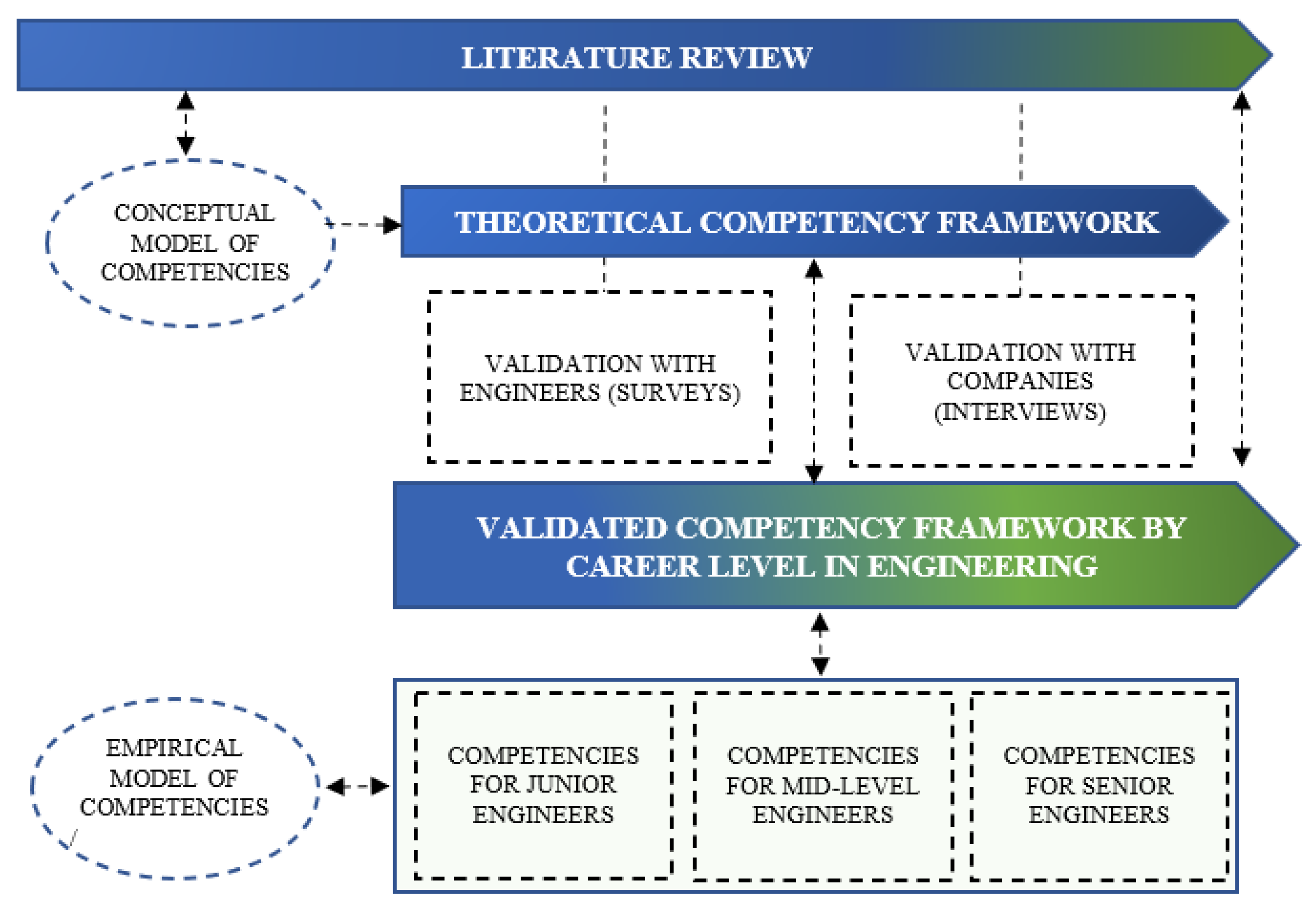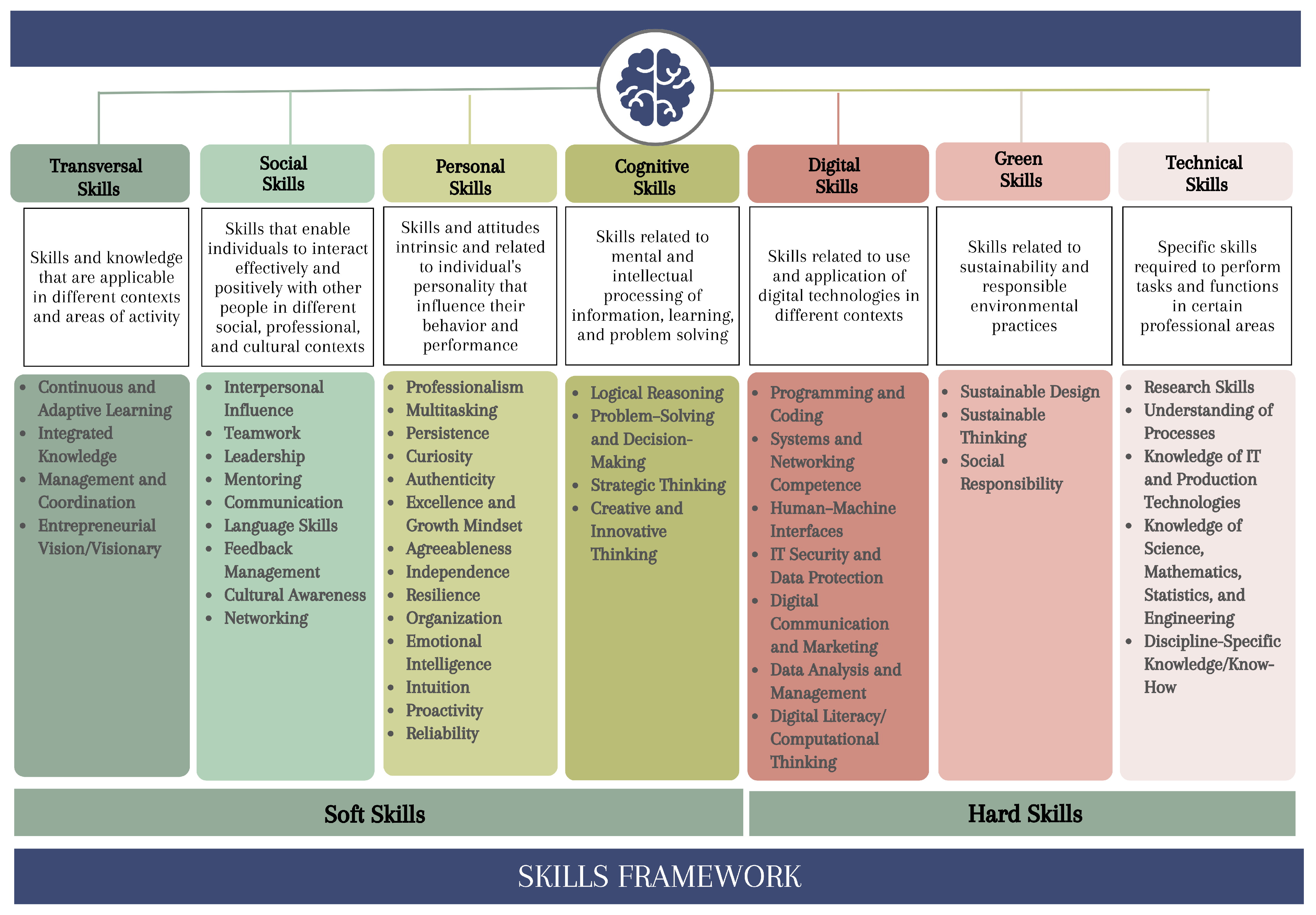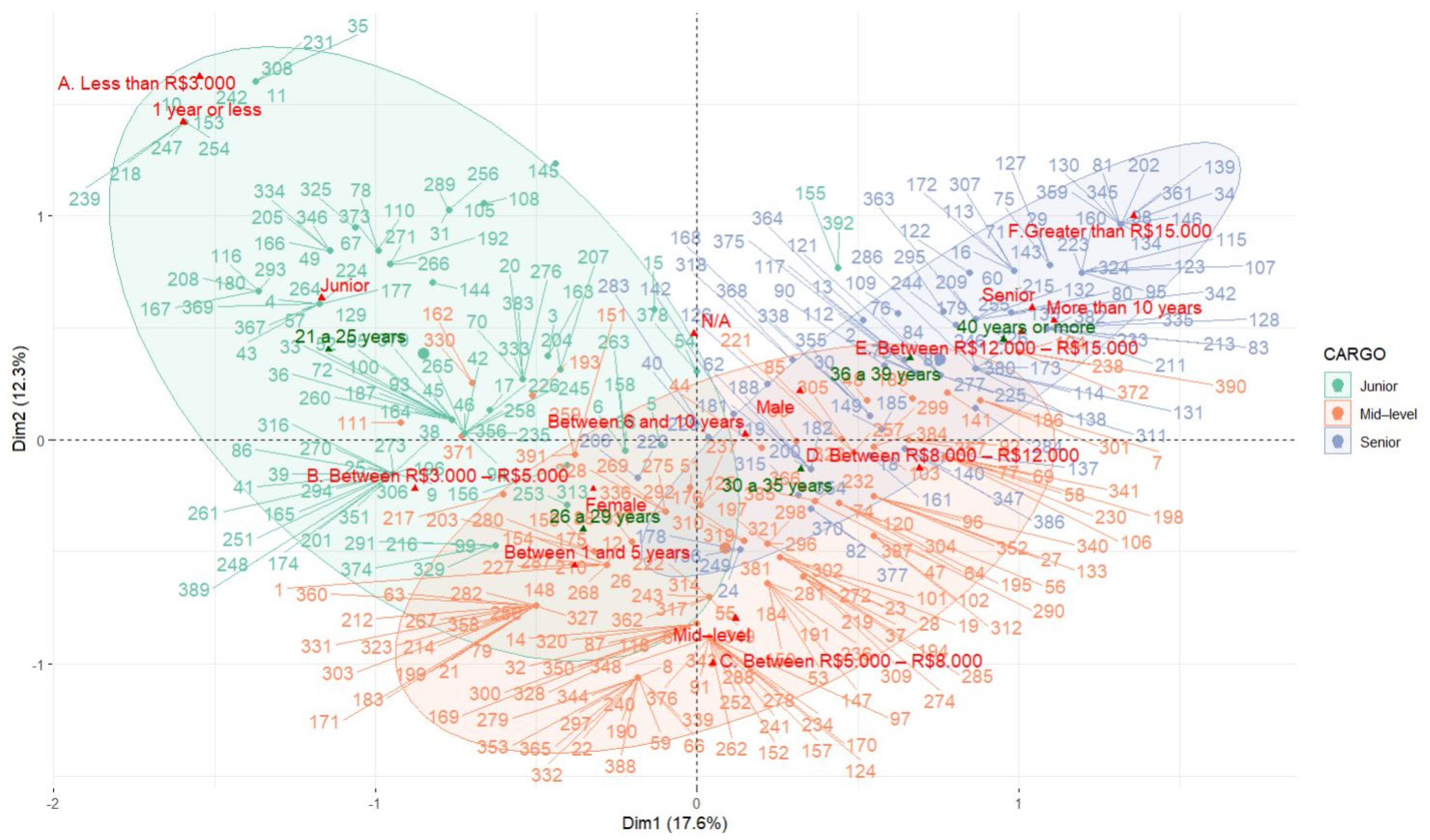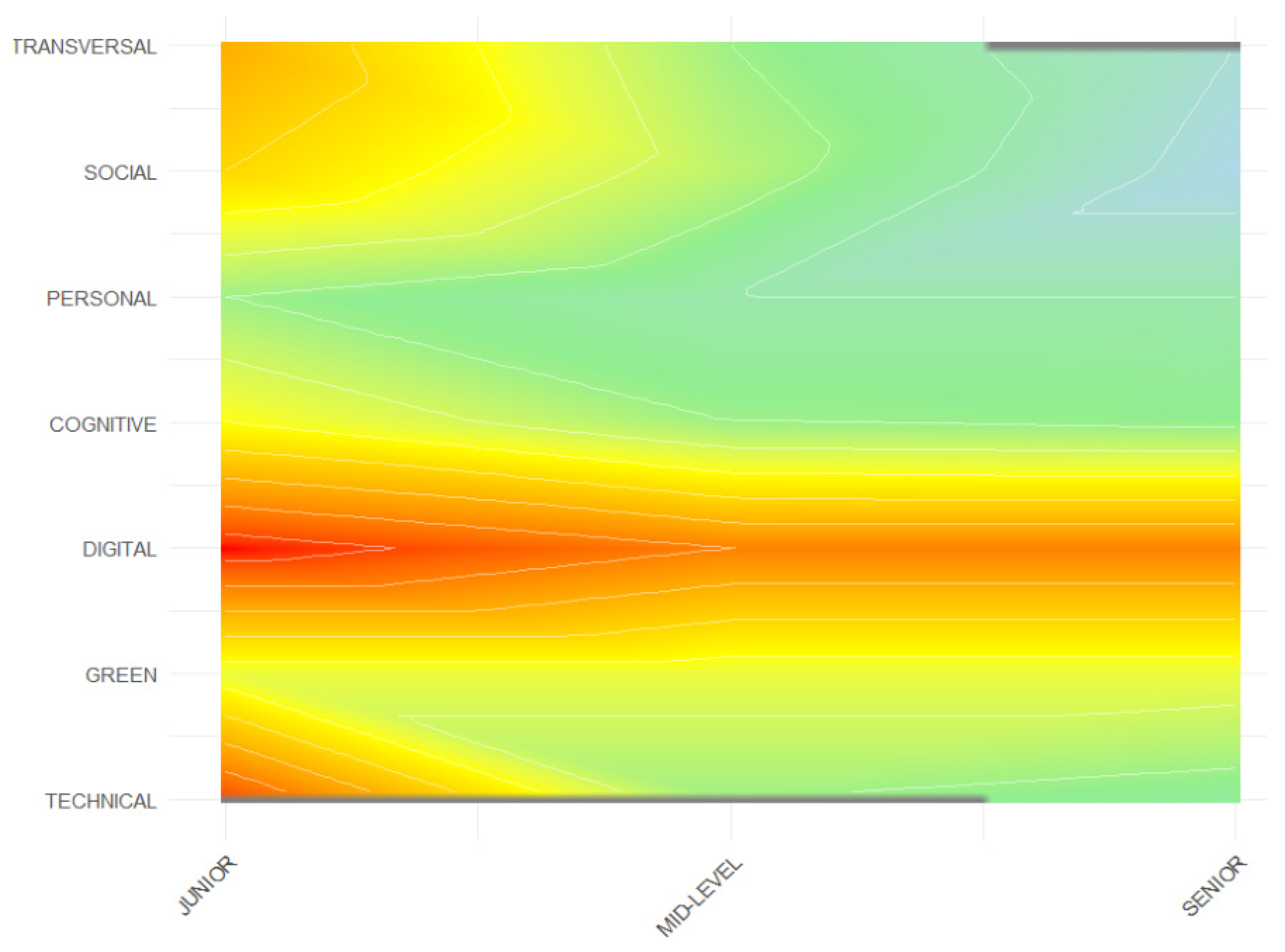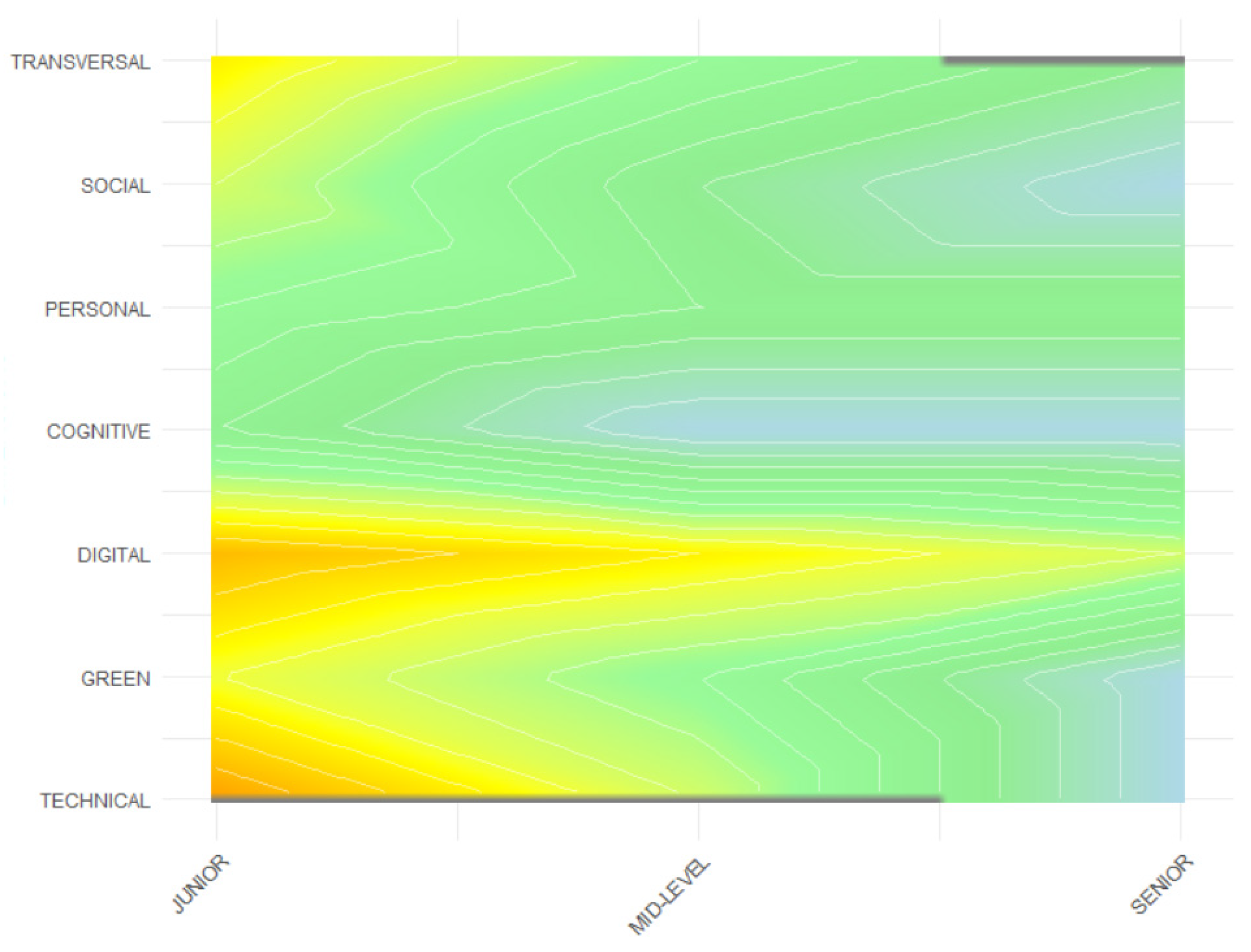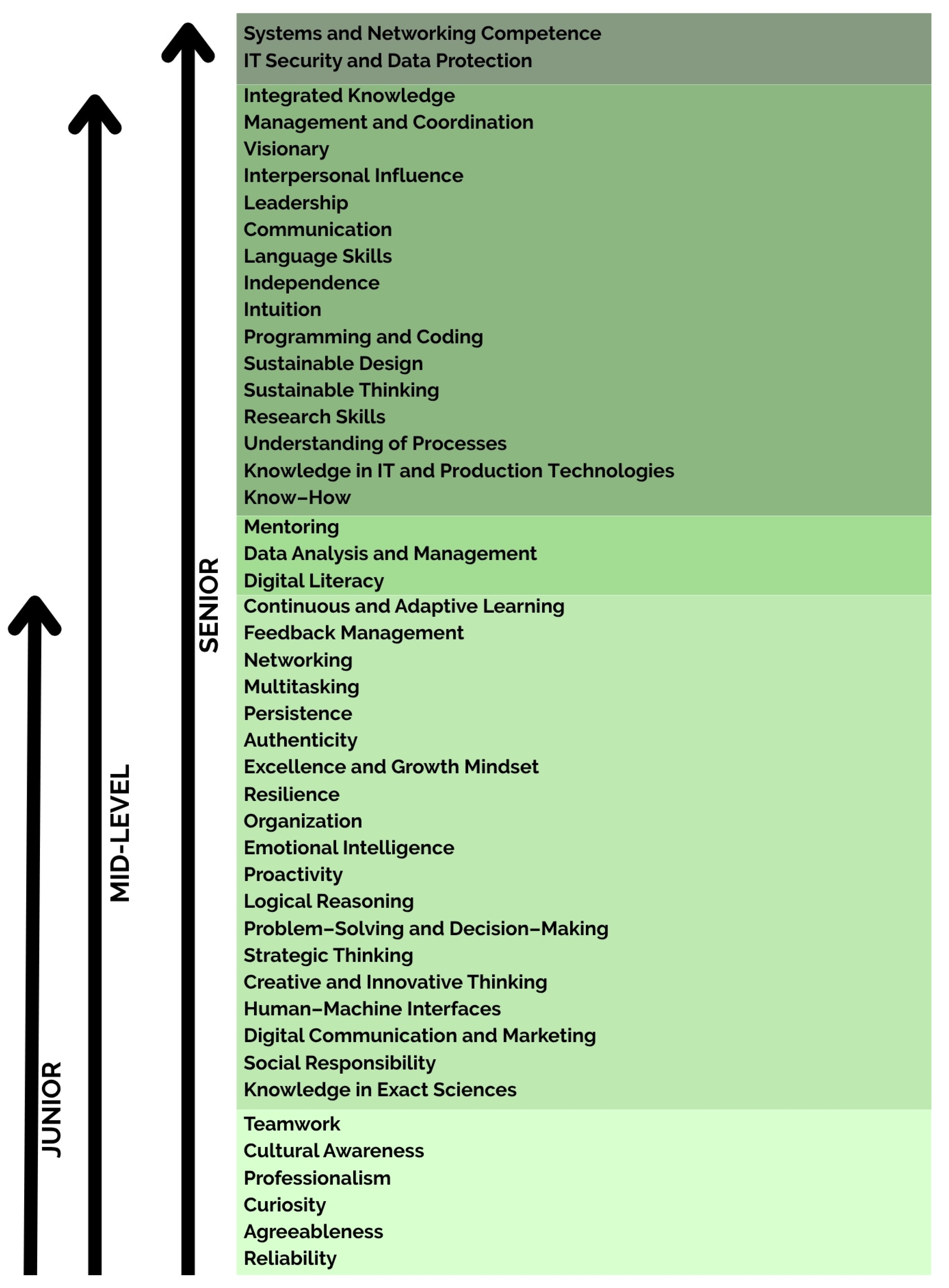4.1. Theoretical Competency Framework
The competencies comprising the theoretical framework were organized into seven dimensions: transversal (4), social (9), personal (14), cognitive (4), digital (7), green (3), and technical (5)—
Figure 2.
The classification of competencies by dimensions is essential to understanding the role of each type of skill in the professional performance of engineers, especially in light of the transformations driven by Industry 4.0.
Several studies emphasize that many of these competencies require continuous development, both during academic training and professional practice. According to [
43], for example, although digital skills are widely recognized as critical, proficiency levels among engineering students remain moderate to low, particularly in areas such as digital literacy and problem-solving.
In addition to digital and technical competencies, studies such as [
45,
61] highlight the growing importance of interpersonal and cognitive skills, such as teamwork, continuous learning ability, and effective communication. These competencies are often classified as soft skills, encompassing transversal, personal, social, and cognitive dimensions. They prove fundamental for professional success, as they enable engineers to collaborate, lead, and innovate in increasingly dynamic and complex environments.
In this context, the literature points out that an interdisciplinary approach in STEM education can promote the integrated development of these skills [
9,
61]. However, development efforts should not be limited to educational institutions. The study by [
62], for instance, reveals that one-third of leaders do not guide their teams toward developing new leaders, which highlights the existing gap in internal talent development within organizations.
Therefore, the improvement of engineers’ competencies requires shared responsibility among universities, companies, and society itself. Universities should rethink their curricula to incorporate active methodologies, competency-based teaching, and interdisciplinarity. In turn, companies must strategically invest in the development of their professionals, focusing not only on technical skills but also on human, adaptive, and leadership competencies [
11,
45].
The theoretical framework proposed here addresses the gap in the literature, which often presents generic and scarcely operational classifications. By proposing a more detailed and dimensional model, this study contributes to building practical and up-to-date references for the development of engineers capable of performing in the digital era. This structure is also consistent with the demands of Industry 4.0, which requires a workforce that is technically prepared but also highly adaptable, collaborative, and strategic [
45,
63].
4.2. Validation of Theoretical Competency Framework with Engineers
4.2.1. Demography
The sample of 392 participating engineers showed heterogeneity across different levels of professional seniority, as shown in
Table 1.
To verify the existence of a statistically significant association between categorical variables in the sample, the Chi-Square (χ
2) Test of Independence was applied to the following variable combinations: gender and age, gender and salary, age and salary, position and salary, position and gender, and position and age, as shown in
Table 2.
The results presented in
Table 2 indicate that all associations between the analyzed variables were statistically significant. Therefore, with the aim of jointly exploring the association patterns among respondent profiles, a Multiple Correspondence Analysis (MCA) was conducted to investigate these patterns [
57] (
Figure 3).
The biplot generated by the Multiple Correspondence Analysis (MCA), shown in
Figure 3, presents individuals (gray numbers) distributed according to their response categories and grouped by hierarchical level (junior, mid-level, and senior).
The visualization reveals three well-defined clusters:
The junior-level professionals cluster (in green) is positioned in the upper-left quadrant of the plot and tends to be associated with characteristics such as age between 21 and 25 years, salary below BRL 3000 or between BRL 3000 and BRL 5000, and work experience between 1 and 5 years.
The mid-level professionals cluster (in orange) is concentrated in the central region of the plot, associated with intermediate salary ranges (between BRL 5000 and BRL 8000), work experience between 6 and 10 years, and ages between 26–29 and 30–35 years. There is also a gender balance within this group.
The senior-level professionals cluster (in blue) is located in the upper-right quadrant, linked to categories such as salaries above BRL 12,000, more than 10 years of professional experience, and ages over 40. This group also shows a higher concentration of male respondents.
The distribution of categories highlights clear career progression patterns, with higher levels associated with increased age, work experience, and compensation—reinforcing the internal consistency of the data. Additionally, the moderate overlap between gender and professional level suggests that, although there is some symmetry, structural differences in professional profiles between men and women persist, especially at the higher salary levels.
4.2.2. Engineers’ Perception of Their Competencies
This stage aimed to assess which competencies appear to be more consolidated or deficient throughout the professional trajectory, as well as to identify evolutionary patterns across junior, mid-level, and senior positions. This practical validation is essential to ensure the applicability of the proposed model in real-world contexts of engineering education and professional development.
Table 3 presents the results of the Chi-Square Test of Independence.
Based on the study in [
64], it is evident that the development of competencies throughout engineers’ careers does not follow a single standardized pattern, being influenced by various contextual, educational, and professional factors. The authors highlight that the lack of consensus on which knowledge, skills, attitudes, and experiences constitute a global competency has resulted in heterogeneous training interventions and, in many cases, certification programs lacking robust scientific foundations.
This observation reinforces the findings presented in
Table 3, which identified statistically significant differences in the mastery of 24 competencies among engineers at different hierarchical levels (junior, mid-level, and senior). These differences suggest that competencies develop progressively and unevenly, reflecting the accumulation of practical experience, the assumption of responsibilities, and the organizational contexts encountered throughout one’s career. These data underscore the need for more structured and evidence-based training strategies that recognize the evolution of competencies according to career stage.
Table 4 summarizes the degree of competency development among engineers at the junior, mid-level, and senior stages, based on the questionnaire results and perceptual maps generated in RStudio
® for the 24 competencies that showed significant differences.
The prominence of each competency at each career level was classified into four categories: ++ (highly developed), + (developed), ± (moderately developed), and - (underdeveloped).
According to
Table 4, junior, mid-level, and senior engineers all exhibit highly developed competencies in Continuous and Adaptive Learning, Mentoring, Cultural Awareness, Professionalism, Curiosity, Authenticity, Excellence and Growth Mindset, and Social Responsibility. In addition, they demonstrate good development in competencies such as Resilience, Organization, Emotional Intelligence, Intuition, Strategic Thinking, and Sustainable Thinking, although there is still room for improvement in these areas.
On the other hand, competencies related to Digital Communication and Marketing are classified as moderately developed across all three career levels. Meanwhile, skills in Languages, Programming and Coding, Systems and Networks Competency, Human–Machine Interfaces, IT Security and Data Protection, and Sustainable Design are shown to be underdeveloped or largely lacking among the professionals analyzed.
This scenario highlights a notable deficiency in digital competencies among engineers, pointing to a significant gap in areas that are increasingly critical for digital transformation. This finding is consistent with [
65], which emphasizes that digital skills are no longer optional but have become critical competencies for contemporary professional practice. Furthermore, ref. [
65] emphasizes that these skills must be developed in conjunction with social competencies, forming an integrated set that prepares professionals for the complex and interdisciplinary challenges of the digital age.
When evaluating the competencies that showed statistically significant differences, early-career professionals (junior engineers) stood out, particularly in essential personal and cognitive competencies.
Like junior engineers, mid-level engineers also exhibited a lack of digital skills. The most developed competencies were predominantly found among senior engineers, although their areas for improvement mirrored those of the mid-level group.
The analyzed data reveal a consistent pattern of competency evolution throughout the engineers’ career paths, with a clear progression in the development of transversal, social, and cognitive competencies as they advance in their careers. While junior engineers stand out for fundamental personal and cognitive traits, mid-level and senior engineers expand this repertoire, demonstrating growing mastery in transversal and social competencies.
However, a recurring and concerning finding across all experience levels is the low proficiency in digital competencies—particularly in programming, information security, and systems and networks. This gap represents a significant limitation in meeting the demands of digital transformation, regardless of career level.
The study in [
66] supports this concern, highlighting a strong demand for both basic and advanced IT skills for effectively performing tasks in today’s work environment. This reinforces the notion that mastering such competencies is no longer optional but has become a fundamental requirement for professional performance.
Figure 4 presents a heatmap summarizing how engineers self-assessed their performance across the seven mapped competency dimensions. The cooler colors and positions toward the outer regions of the heatmap indicate more developed dimensions, while warmer colors, with competencies located closer to the center, represent less developed dimensions.
4.2.3. Analysis of Relationship Between Engineers’ Competencies
To analyze whether there is a relationship between the engineers’ skills, Multiple Correspondence Analysis (MCA) was carried out for each dimension of the framework. For transversal competencies, evidence of strong associations between them was found.
It is noticeable that when an engineer demonstrates low levels of Management and Coordination, they also tend to show poor Continuous and Adaptive Learning, limited Integrated Knowledge, and a lack of Visionary thinking. The opposite is also true.
In the MCA of social competencies, the competencies rated with the highest score (5)—such as Leadership, Networking, Teamwork, Interpersonal Influence, Feedback Management, Mentoring, Communication, and Cultural Awareness—appeared grouped and located near the senior level on the plot. This suggests that these skills are commonly associated with more experienced professionals and those in higher-responsibility positions.
Conversely, lower scores for competencies such as Teamwork, Mentoring, Networking, and Interpersonal Influence were strongly isolated on the far left side of the plot. This reinforces the idea that underdevelopment in these areas tends to concentrate within a specific group of individuals.
The MCA for personal competencies indicated that professionals with low Persistence also tend to show low Independence. Likewise, when low scores are given for Agreeableness, they are also associated with low levels of Trustworthiness and Professionalism. A low rating in Excellence and Growth Mindset is also linked to low levels of Curiosity and Resilience.
Junior-level professionals exhibited intermediate characteristics and were more dispersed across the plot, indicating a diversity of profiles. More experienced profiles, on the other hand, were strongly associated with high levels of behavioral competencies. These findings are consistent with the work of [
64].
The MCA for cognitive competencies revealed that engineers struggling with Problem-Solving and Decision-Making were also associated with low levels of Logical Reasoning and Strategic Thinking.
The MCA plot for digital competencies showed a clear relationship among them. Junior, mid-level, and senior positions appeared near the center of the plot, adjacent to intermediate competency levels (levels 2 to 4). This suggests a continuous progression between digital competency development and career advancement, as also evidenced in
Table 4. This configuration reinforces the notion that the development of digital competencies is a key competitive advantage for career growth.
The MCA plot for green competencies revealed a strong association among the three sustainability-related competencies, indicating a high level of homogeneity in responses. However, the competency Sustainable Design appeared somewhat distant from the others, suggesting that it remains less consolidated among the surveyed engineers. In other words, when an individual scores 4 on Social Responsibility and Sustainable Thinking, they tend to rate slightly lower on Sustainable Design.
Low ratings across all three green competencies also appeared closely grouped, indicating that a lack in one of these areas is typically accompanied by deficiencies in the others.
Finally, the MCA for technical competencies confirmed what had already been inferred from previous analyses: individuals tend to evaluate themselves similarly across all competencies within this dimension.
4.3. The Validation of the Theoretical Framework from a Business Perspective
Table 5 presents, from the companies’ perspective, the competencies that show statistically significant differences among groups of engineers, according to the Chi-Square Test of Independence and the Friedman Test.
Upon analyzing
Table 5, it is observed that most of the competencies that showed statistically significant differences across job levels in the statistical tests were consistent. However, some competencies demonstrated significant differences only in the Friedman Test and not in the Chi-Square Test of Independence. These include Social Responsibility, Human–Machine Interfaces, IT Security and Data Protection, Digital Communication and Marketing, Reliability, Cultural Awareness, and Leadership. This divergence is expected, as the Friedman Test is more sensitive to variations in small samples.
However, when applying the Dunn post hoc test with Bonferroni correction to the competencies that showed a p-value lower than 0.05 in the Friedman Test, only Leadership remained statistically significant after the correction.
Thus, 33 competencies were considered to show significant differences in requirements across job levels (junior, mid-level, and senior) according to human resources professionals. This finding aligns with the study by [
67], in which the authors analyzed thousands of engineering job postings and demonstrated that the demand for professional skills varies substantially according to education level, engineering specialization, and salary range. This variation indicates that the job market clearly differentiates the expected profiles for each career stage, adjusting its requirements according to the complexity of responsibilities and level of autonomy expected.
This reinforces the notion that competencies are not uniformly distributed among engineers but are instead shaped by factors such as education, experience, and responsibilities assigned throughout career progression. Therefore, the differences observed across job levels also reflect market expectations regarding the technical, behavioral, and strategic maturity of professionals at each stage of their careers.
Accordingly, 33 competencies were identified as significantly different, and to understand how these differences manifest between junior, mid-level, and senior positions, both perceptual maps and the adjusted
p-values from the Dunn–Bonferroni test were analyzed. The results can be seen in
Table 6.
Table 6 presents a summary of the labor market’s perception regarding the demand for specific competencies in engineers, according to hierarchical levels (junior, mid-level, and senior). A symbol system was used to represent the degree of expectation companies have for each competency by level:
(++) indicates a high demand for that competency at the respective position.
(+) represents a moderate demand.
(±) signals an expectation of development.
Blank cells, specially highlighted in red, indicate that the market does not expect professionals at that hierarchical level to demonstrate significant mastery or performance in the given competency.
It is noticeable in
Table 5 that most personal and cognitive competencies are equally demanded by HR for all three levels: junior, mid-level, and senior. This finding is supported by [
66,
67], who identified skills such as taking initiative, determining what needs to be done in the absence of guidance, planning and resource management, openness to ideas, creativity, innovative thinking, independence, proper application of knowledge, continuous learning, process orientation, ethical decision-making, and professionalism as some of the “fundamental business knowledge and skills” necessary for current professionals regardless of experience.
When assessing the digital, green, and technical competency dimensions in
Table 5, it becomes clear that these are demanded differently according to the professional’s hierarchical level, indicating a progression expected by HR as engineers advance in their careers. This trend is also observed in certain social and transversal competencies, which gain relevance at higher levels of responsibility and professional autonomy.
This differentiation is further supported by [
67], who found that technical and digital competencies—such as those related to Sciences and Systems Analysis—are more prevalent in job postings requiring higher educational levels, suggesting that these skills are strongly associated with greater technical complexity and responsibility, typical of more senior positions.
Thus, the results of this research reinforce that although some competencies are essential at all career stages, others become crucial only with professional advancement, especially those involving specialized technical mastery and strategic vision.
From the interview results, it is possible to infer that recruiters indicate a greater demand for cognitive and personal competencies at the junior level. Essential competencies for this position include Teamwork, Cultural Awareness, Professionalism, Authenticity, Agreeableness, and Reliability. Although prior experience is not mandatory, internships or practical experience in the field are valued during hiring for junior engineers.
For the mid-level position, the labor market generally expects solid development across all mapped competencies, with an emphasis on cognitive, personal, and social skills. Open-ended responses from interviewees about hiring criteria for mid-level engineers highlight higher expectations regarding professional experience and autonomy level. Mid-level professionals are expected to have solid technical knowledge and practical experience, along with decision-making ability, problem-solving skills, critical data analysis, Interpersonal Influence, and innovation. Resilience, emotional intelligence, professional maturity, a proactive attitude, an emerging leadership profile, and independence were frequently mentioned as well.
In summary, the mid-level role demands a balance between advanced technical knowledge, interpersonal and social skills, and initial management involvement, reflecting an intermediate stage of professional and organizational development.
For the senior level, according to
Table 5, nearly all competencies are highly desirable. Interview responses for senior engineer positions emphasize strong management and leadership skills combined with a solid technical foundation and extensive professional experience. Seniors are expected not only to manage teams, processes, and projects but also to take on strategic responsibilities, develop solutions to complex problems, perform persuasive leadership, mentor, manage feedback, exhibit resilience, and demonstrate professional maturity. In essence, the senior engineer should serve as both a technical and managerial reference, capable of leading with strategic vision and developing new professionals.
Figure 5 provides a visual summary of the competency dimensions most valued by recruiters at each job level: junior, mid-level, and senior engineers.
It is important to highlight that, although the figure presents the dimensions generally, the detailed analysis of each competency revealed internal variations: some specific competencies within the same dimension were more or less desired depending on the job level. Thus, the figure serves as a general synthesis of preferences by dimension but does not replace the detailed individual competency analysis.
As in
Figure 4, cooler colors and positions toward the outer regions of the heatmap indicate more developed dimensions, while warmer colors, with competencies located closer to the center, represent less developed dimensions.
During the interviews, all respondents (100%) confirmed that the mapped competencies fully encompass the demands of the labor market, with no indication of additional competencies perceived as missing. Furthermore, 75% of the interviewees acknowledged that third-party recommendations can influence hiring decisions, highlighting the importance of strong networking regardless of the position.
When asked about their level of satisfaction with their currently hired engineers, most respondents reported a high satisfaction level (between 4 and 5). There were few lower ratings (2 or 3), indicating overall good performance in hiring from the HR perspective, with an average rating of 3.83.
4.4. Competency Framework Refined by Career Level
Based on the convergence of data from the literature, professionals’ self-assessments, and recruiters’ perceptions regarding the 46 mapped competencies, a structural competency model for engineers was proposed, organized into three levels of professional maturity: junior, mid-level, and senior. The model aims to reflect the expected progression in competency development throughout a career, aligning with the demands of digital transformation and the increasing complexity of responsibilities at each hierarchical level.
The quantitative and qualitative results revealed a clear evolution of competencies along engineers’ professional trajectories, as previously predicted by [
66,
67]. The data cross-analysis demonstrated not only the technical and behavioral progression of professionals but also highlighted the most sensitive gaps from the market perspective.
The analysis of self-assessments and interviews indicates that, for early-career engineers, there is a strong emphasis on basic personal and cognitive competencies. However, it is noticeable that junior-level engineers currently available in the market still need to improve certain skills requested by recruiters, such as Teamwork, Reliability, Problem-Solving and Decision-Making, Creative and Innovative Thinking, Human–Machine Interfaces, Digital Communication and Marketing, and mathematical knowledge. Additionally, most digital and technical competencies require development.
In this context, previous studies have examined the impact of implementing enabling technologies—such as the Internet of Things (IoT) and Virtual Reality (VR)—to enhance learning and development programs. These advanced technologies have demonstrated their potential to improve human capabilities in problem-solving by strengthening relevant skills, behaviors, and knowledge. Thus, the integration of such technologies into professional development strategies may help accelerate the readiness of junior engineers for the demands of the digital era [
68].
Thus, the Junior engineer is understood as a professional in a phase of practical training, characterized by consistent behavioral traits and adaptability. This perspective is reinforced by [
69], who point out that the competencies of early-career engineers tend to vary depending on the professional roles they occupy, contributing to greater heterogeneity in competencies observed among juniors. This diversity reflects not only the specific demands of each organizational context but also the different technical and interpersonal development paths these professionals may follow in the initial stages of their careers.
For mid-level engineers, the data converge toward a significant appreciation of cognitive, personal, and social competencies. From the market’s point of view, mid-level professionals still need improvement in competencies such as Networking, Multitasking, Persistence, Resilience, Emotional Intelligence, Logical Reasoning, Problem-Solving and Decision-Making, Strategic Thinking, and Digital Literacy. The expectation is that these engineers begin to act as references for younger colleagues, also developing competencies related to emerging leadership [
70].
This expectation is further reinforced by recent findings indicating that Mid-level Managerial Competencies (MMCs) have a significant and direct positive impact on a company’s intention to adopt Industry 4.0 technologies. As MMCs increase, so does the organization’s willingness to embrace digital transformation. Notably, this relationship is not mediated by Industry 4.0 readiness or perceived usefulness, underscoring that MMCs exert an independent influence on digital adoption decisions. These insights highlight the crucial role of mid-level professionals in driving technological change, emphasizing the need to strengthen their leadership and strategic competencies to ensure a smooth and successful transition to Industry 4.0 [
70].
At the top of professional maturity, senior engineers are perceived as reference professionals who accumulate experience across the seven mapped dimensions. The competencies most emphasized at this level, compared to mid-level engineers, include Integrated Knowledge, Management and Coordination, Visionary Thinking, Interpersonal Influence, Leadership, Communication, Language Skills, Independence, Organization, Intuition, Programming and Coding, Sustainable Design, Sustainable Thinking, Research Skills, Process Understanding, IT and Production Technologies Knowledge, and Know-How.
This set of competencies aligns closely with those typically attributed to top management, who are instrumental in promoting a culture of innovation and enabling technological advancement within organizations. Senior professionals, particularly those in leadership or strategic roles, play a key part in fostering an environment conducive to experimentation, reducing resistance to change, and facilitating the successful adoption of Industry 4.0 initiatives. Their ability to influence decision-making, allocate resources, and guide interdisciplinary teams reflects the essential contribution of Top Management Team Competencies (TMTCs) in driving digital transformation and supporting long-term organizational readiness for Industry 4.0 [
70].
Regarding the senior engineers available in the market, there is a lack of Language Skills, Organization, Intuition, and especially digital competencies. Both self-assessments and recruiters’ perceptions indicate that team management, the development of complex solutions, and the ability to influence and technically guide others are indispensable aspects at this level. There is also a clear expectation of mastery over advanced technological tools and performance indicators, although, in practice, some senior engineers also show limitations in digital skills.
The comparison between the two approaches—engineers’ self-assessment and recruiters’ (companies’) perception—confirmed that the 46 mapped competencies are sufficient to cover current market demands, with no need for additions.
However, a structural gap became evident: digital competencies were systematically assessed as underdeveloped across all levels. This deficit was pointed out by both engineers and companies, revealing a concerning mismatch with the demands of digital transformation. This finding becomes even more critical given the scenario described by [
66], who highlight that the use of digital skills has become an integral part of daily professional activities and is determinant for organizational success. Furthermore, the lack of digital proficiency may entail significant risks to information security, especially when employees access networks or devices without proper protections, exposing sensitive company and client data.
The proposed structural model in
Figure 6 suggests a linear and multidimensional evolution of competencies, with an initial emphasis on personal and cognitive skills, technical and social maturation for mid-level engineers, and strategic and leadership integration at the senior level. The model recommends the intentional and progressive incorporation of digital competencies throughout the entire career path as a fundamental transversal axis for engineers’ performance in the Industry 4.0 context, as already stated by [
65,
66].
One of the main differentiators of this research lies in the integration of the engineers’ perspective with the views of human resources professionals and managers responsible for their hiring. While much of the existing literature on competencies relies on theoretical analyses or the perception of academic experts, this study sought to directly engage the market—both from the standpoint of those occupying engineering roles and those defining the hiring criteria.
This approach added robustness and practical relevance to the findings, enabling the validation of identified competencies not only conceptually but also in their real application within organizational settings. Thus, the study significantly contributes to aligning education, professional practice, and market expectations, fostering a more accurate understanding of industry demands and providing concrete guidance for educational institutions, professional development programs, and capacity-building policies targeting engineering in the digital transformation era.
